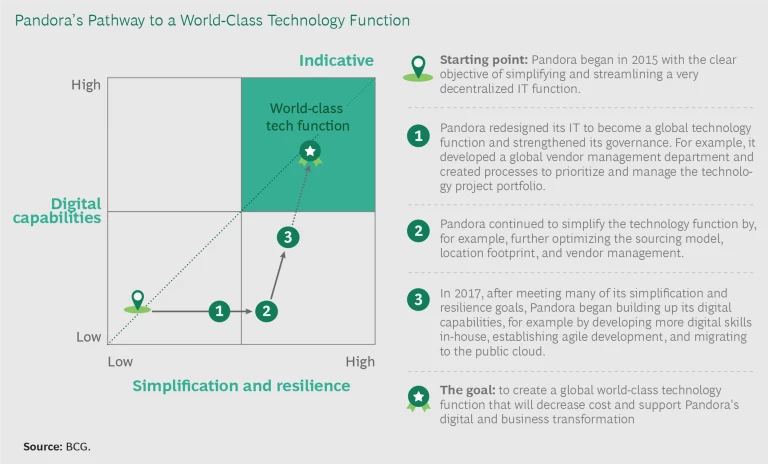A new generation of exciting technologies—part of the fourth industrial revolution—is driving the move toward machine-augmented, data-driven, bionic organizations. Yet many corporate leaders are beginning to realize that their IT departments are not capable of properly leveraging these technologies to reinvent products and services, meet changing customer demands, and keep pace with digital disrupters.
To compete, organizations need to develop world-class technology functions (WCTFs) that create strategic differentiation by enabling new digital capabilities and increasing the enterprise’s simplification (to drive cost savings) and resilience—to deal with a variety of adverse developments, including cyber attacks, industry crises, and economic downturns. (See “The Characteristics of a WCTF.)
The Characteristics of a WCTF
The Characteristics of a WCTF
We have identified six dominant WCTF characteristics on the basis of several hundred projects. Each of these characteristics creates strategic differentiation by enabling new digital capabilities and increasing the enterprise’s simplification (to drive cost savings) and resilience.
- A modern, simplified, application, data, and technology infrastructure landscape that incorporates digital-ready architecture, next-generation enterprise resource planning, and advanced data analytics capabilities, which can leverage public or private cloud technologies.
- An operating model based on close collaboration between business and the technology function and created by applying agile work methodologies across the entire company. This includes a simplified organizational structure, optimized technology processes, and a suitable location setup.
- A future-ready technology workforce, leadership, and culture focused on hiring, training, and retaining talent with the right digital and tech skill sets and increasing the share of engineering experts (defined as developers with coding skills on at least three platforms) within the workforce.
- A well-defined ecosystem and sourcing model, including a strategic split between what the company decides to build rather than buy; digital partnerships, including with nontraditional providers; agile sourcing capabilities; and state-of-the art management of suppliers.
- Leading-edge cybersecurity capabilities that can both combat the rise in cyber attacks of roughly 20% per year and protect internal assets as well as products.
- A technology function that participates as an equal with the business in all key digital programs—for example, digital supply chain and Industry 4.0—and that looks for synergies between enterprise IT and operational technology.
The Barriers to Transformation
In our work, we have seen firsthand the benefits of putting a WCTF in place: for example, a 300% to 400% rise in customer satisfaction and return on digital investment, a 200% to 400% acceleration in delivery, a 15% to 20% shift from indirect to direct technology activities, and a 15% to 25% reduction in development costs. But making the transition to a WCTF and achieving these kinds of results is far from easy.
A WCTF can result in a 300% to 400% rise in customer satisfaction and return on digital investment.
Modern technology functions have evolved beyond just enterprise IT. They now tend to also include operational technology (OT) or production technology, and they pay attention to all enterprise and OT in any subsidiaries or startups in which their company owns a majority position.
Yet, for many years, most companies have viewed the IT function as just another support function, along the lines of accounting, PR, and human resources. Consequently, IT departments have experienced multiple rounds of cost cutting.
In addition, they have faced pressure to outsource, which means that these capabilities no longer remain in-house and are with the IT vendors only—often resulting in a loss of critical capabilities.
The IT function in many industries also still operates as a traditional enterprise department—weighed down by legacy systems, with data scattered across the organization. In such cases, the business and technology units typically work in silos. As a result, the business side often feels that IT is not delivering solutions fast enough. At the same time, the lack of close collaboration can also result in major investments failing to deliver because of insufficient alignment or buy-in with the business. When this occurs, a shadow IT function often emerges that is unaligned with the central IT, creating even more complexity.
Companies must begin treating the IT function as a strategic business partner and digital business enabler instead of a service provider. To do so, however, they will need to fight long-ingrained habits and ways of doing business. In other words, they will have to undergo a fundamental change in mindset.
Companies must begin treating the IT function as a strategic business partner and digital business enabler instead of a service provider.
A recent BCG survey of 150 companies across industries worldwide highlights the extent of this challenge: 55% of companies reported that IT is still seen as a service provider and not a strategic partner to the business; only 17% of companies have agreed on a digital-ready application landscape that allows for providing new digital services as efficiently as digital natives do; and only 32% of companies have a strategy to migrate from traditional architectures to modern, service-oriented ones, such as microservices.
Pathways to a WCTF
To overcome these barriers and transform IT into a world-class technology function, companies need to build up digital capabilities and increase simplification and resilience. Though some companies have the resources to pursue both objectives equally and simultaneously, most will need to decide how to balance the two and where to put their focus. Success depends on keeping both in mind and choosing the right mix.
A company that chooses to focus more on building up digital capabilities, for example, could decide on some combination of the following priorities:
- Build a modern data and digital platform embracing digital design. This includes big data and analytics capabilities, the ability to leverage the cloud, and next-generation enterprise resource planning (ERP) systems.
- Have a multidisciplinary team develop high-value use cases on the basis of financial impact, strategic value, and resource availability in order to deliver business impact while building capabilities.
- Improve business and technology collaboration by applying agile ways of working to development and operations—not just for pilot projects but at scale.
- Hire, train, and retain talent with the right digital and tech skill sets—such as digital architects, application developers, user interface and user experience designers, and cybersecurity specialists. They can do so by, for example, setting up engineering incubators, which teach hands-on coding, encourage an experimental engineering culture, create well-defined expert career tracks, and set metrics to measure efficiency and investment returns. (Incubators have been known to increase the percentage of expert engineers in a company’s technology workforce from 10% to about 50%.)
Another company might choose to focus more on increasing simplification and resilience of the technology function. This company’s priorities might include a combination of the following:
- Simplify the supplier portfolio by reducing suppliers (cut the long tail and adjust the tier-1 and tier-2 suppliers) and improving management by, for example, using the same metrics for all vendors and streamlining contracting for procuring digital services or digital solutions or both.
- Improve security governance and management to prevent, detect, respond, and recover from cyber attacks and security breaches.
- Pursue synergies by combining enterprise IT with operational and production technology. This could be done, for example, by enforcing architecture standards, putting one CIO or CTO in charge of all technology, or both.
Getting the Right Mix
Choosing how much to focus on each objective is critical. Getting it right will depend on:
- The Individual Starting Point. This hinges on how mature the company’s technology function is in terms of digital capabilities and simplification and resilience.
- The Business Objectives of the Company. These objectives usually involve some combination of the following: lower costs, often through achieving efficiencies; more speed and the ability to deliver value quickly; better workforce capabilities and culture; and secure and stable operations.
- Other Contextual Factors. These are factors that must be taken into account, such as a large, ongoing ERP transformation program that a company could leverage to improve capabilities; budget limitations that might force a company to simplify and reduce cost and then hopefully self-fund the capability to build; a demerger restructuring; and post-merger integration activities.
Renault. This international car manufacturer focused mainly on building up digital capabilities to accelerate its digital transformation in order to tap into new technologies in areas such as connected cars, autonomous cars, and data analytics. It applied three main levers.
First, it built a digital platform that would work alongside its legacy systems, consolidate data spread across more than 2,000 applications, and make the data accessible and usable. This effort also reinforced the simplification of legacy systems by, for example, defining a single source of truth and reducing ERP versions.
Second, the company moved to adopt agile ways of working for new projects, bringing in scrum masters and agile coaches to support the transition. Renault also upgraded tools to facilitate real-time collaboration and information sharing for teams, which has been very valuable because team members often travel around the world.
Finally, the company committed to hiring new tech talent and retraining existing teams to work with the new technologies.
A Leading Australian Consumer Brand. This company also focused on building digital capabilities. To guide the development of new digital products and services, the company created multidiscipline agile teams led by the business owners. To support these teams’ development efforts, the company added a layer of application programming interface services onto the existing application landscape and selectively implemented new software to replace legacy systems and simplify the application landscape at the same time. For example, it added a core customer relationship management (CRM) system with state-of-the-art customer data management and flexible front-end development capabilities. It also ensured access to the right mix of skills from internal staff, contractors, and vendors to get the most out of the new CRM system.
Pandora. This global jewelry manufacturer and retailer chose to place a stronger focus on increasing simplification and resilience of the technology function. The company began in 2015 with a clear objective: to simplify and streamline its highly decentralized IT. First, Pandora redesigned its IT to become a global technology function and strengthened its governance. For example, the company developed a global vendor management department and created processes to prioritize and manage the technology project portfolio. Pandora also implemented several global applications, such as an HR system and ERP system, that allowed the company to switch off many regional apps and thus greatly simplify the application landscape.
Pandora continued to simplify the technology function—for example, by further optimizing the sourcing model, location footprint, and vendor management. But about two years ago, with many of its simplification and resilience goals fully met or well underway, the company turned toward a stronger focus on building up its digital capabilities, such as developing more digital skills in-house, establishing agile development for front-end applications, and beginning to migrate to the public cloud. All these activities helped to decrease cost while increasing resilience and to improve capabilities that support Pandora’s business and digital transformation. (See the exhibit.) The next step is to leverage the public cloud further and build the data and digital platform layer to better support advanced analytics and AI use cases.
Steps for an Ongoing Transformation
A company must take steps to ensure that the transformation stays on track through all its stages. To this end, a strong commitment and involvement by the CEO and other top executives is vital. It would be difficult to overemphasize this point. Designing a WCTF must be high on the agenda of senior management—and the team needs substantial tech proficiency within its ranks to drive the transformation. The organization should take the following steps:
- Conduct an assessment to determine the maturity of the technology function, especially the status quo of the company’s digital capabilities and simplification and resilience, and compare these results against benchmarks and industry peers. To be comprehensive, this assessment needs to include feedback on the technology function’s performance from key business stakeholders. This assessment determines the starting point.
- On the basis of this assessment, leaders need to identify key strengths and weaknesses and define their goals for both digital capabilities and simplification and resilience. Companies also need to make sure that they leverage whatever investments they are already making in their ERP transformations to get as close as possible to their goals. For example, the current migration from SAP R/3 to S/4HANA, to be completed by 2025, gives companies the opportunity to think beyond just an upgrade. For example, they can consider more broadly how to leverage the migration to get more value out of company data or reassess the line of demarcation between SAP and software-as-a-service-supported business processes.
- Embed any new initiatives and adjustments in a transformation roadmap for the technology function. The company also needs to select KPIs to track the progress of individual initiatives and the success of the transformation over time.
Though the challenges of creating a WCTF are enormous—in terms of changing mindsets, developing new ways of working, and strengthening existing systems—leaders have some flexibility for how they bring about this transformation. They can choose the pathway that strikes the right balance between developing digital capabilities and pursuing simplification and resilience on the basis of the organization’s starting point, business objectives, and other contextual factors.
This choice has become critical as business and technology groups begin to work together more closely; often, the business takes on more responsibility for developing digital capabilities. Yet the collaboration comes with a risk of increased technology cost and complexity. Thus, it’s important to also identify the right areas for simplification and cost savings—for example, such as in ERP, and cloud services, which often do not provide differentiation for the company.







